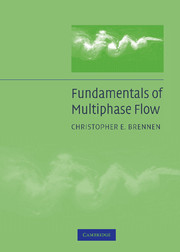Book contents
- Frontmatter
- Contents
- Preface
- Nomenclature
- 1 Introduction to Multiphase Flow
- 2 Single-Particle Motion
- 3 Bubble or Droplet Translation
- 4 Bubble Growth and Collapse
- 5 Cavitation
- 6 Boiling and Condensation
- 7 Flow Patterns
- 8 Internal Flow Energy Conversion
- 9 Homogeneous Flows
- 10 Flows with Bubble Dynamics
- 11 Flows with Gas Dynamics
- 12 Sprays
- 13 Granular Flows
- 14 Drift Flux Models
- 15 System Instabilities
- 16 Kinematic Waves
- Bibliography
- Index
4 - Bubble Growth and Collapse
Published online by Cambridge University Press: 05 June 2014
- Frontmatter
- Contents
- Preface
- Nomenclature
- 1 Introduction to Multiphase Flow
- 2 Single-Particle Motion
- 3 Bubble or Droplet Translation
- 4 Bubble Growth and Collapse
- 5 Cavitation
- 6 Boiling and Condensation
- 7 Flow Patterns
- 8 Internal Flow Energy Conversion
- 9 Homogeneous Flows
- 10 Flows with Bubble Dynamics
- 11 Flows with Gas Dynamics
- 12 Sprays
- 13 Granular Flows
- 14 Drift Flux Models
- 15 System Instabilities
- 16 Kinematic Waves
- Bibliography
- Index
Summary
Introduction
Unlike solid particles or liquid droplets, gas/vapor bubbles can grow or collapse in a flow and in doing so manifest a host of phenomena with technological importance. We devote this chapter to the fundamental dynamics of a growing or collapsing bubble in an infinite domain of liquid that is at rest far from the bubble. Although the assumption of spherical symmetry is violated in several important processes, it is necessary to first develop this baseline. The dynamics of clouds of bubbles or of bubbly flows are treated in later chapters.
Bubble Growth and Collapse
Rayleigh–Plesset Equation
Consider a spherical bubble of radius, R(t) (where t is time), in an infinite domain of liquid whose temperature and pressure far from the bubble are T∞ and p∞(t) respectively. The temperature, T∞, is assumed to be a simple constant because temperature gradients are not considered. Conversely, the pressure, p∞(t), is assumed to be a known (and perhaps controlled) input that regulates the growth or collapse of the bubble.
Though compressibility of the liquid can be important in the context of bubble collapse, it will, for the present, be assumed that the liquid density, ρL, is a constant. Furthermore, the dynamic viscosity, µL, is assumed constant and uniform. It will also be assumed that the contents of the bubble are homogeneous and that the temperature, TB(t), and pressure, pB(t), within the bubble are always uniform. These assumptions may not be justified in circumstances that will be identified as the analysis proceeds.
- Type
- Chapter
- Information
- Fundamentals of Multiphase Flow , pp. 73 - 96Publisher: Cambridge University PressPrint publication year: 2005
- 4
- Cited by



